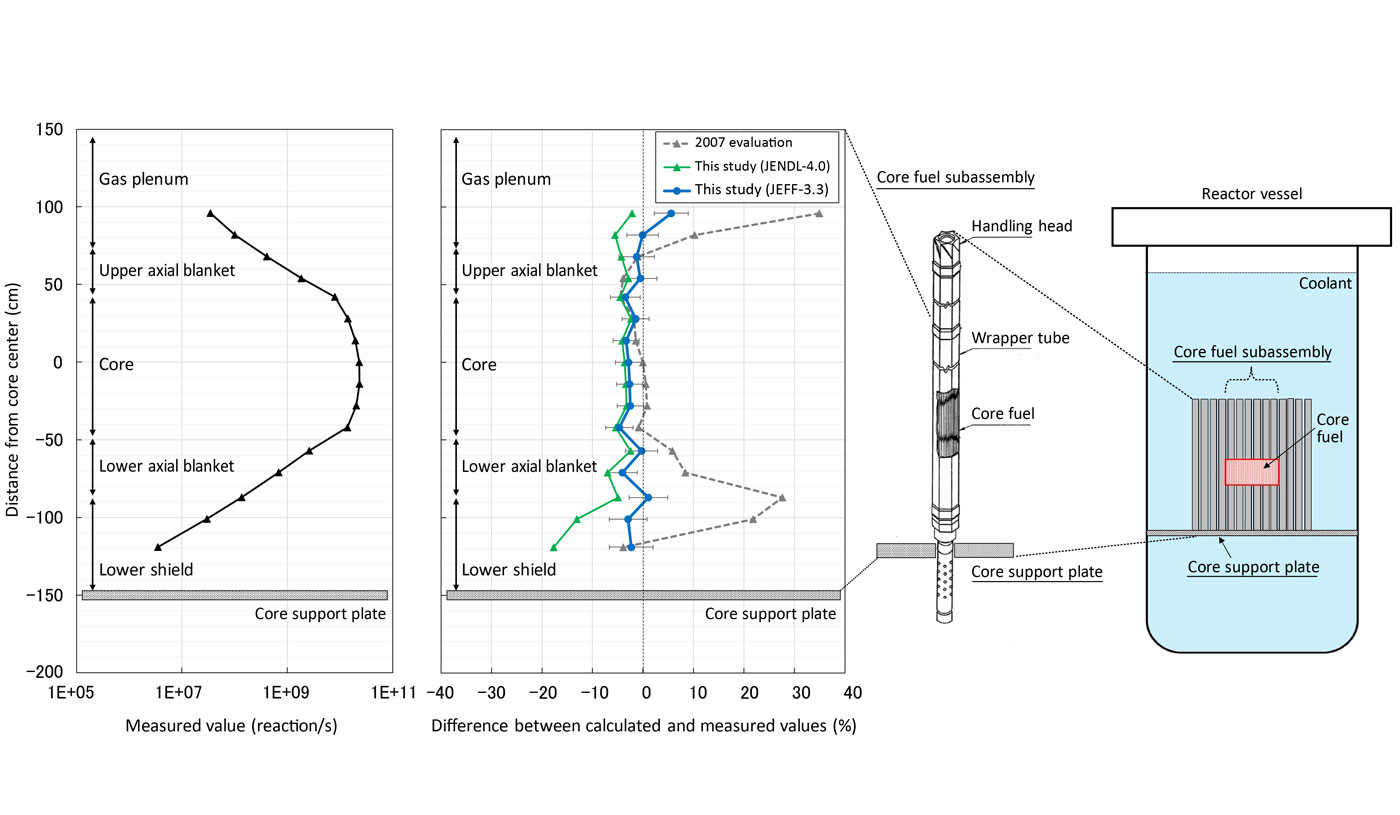 |
Topics
For Reliable Shielding Design of Fast Reactors
−Evaluation of Calculation Accuracy for Neutron Fluence in Core Support Plate with “Monju” Data−

Fig. 1 Calculation accuracy of Ni-58 (n, p) reaction rate
The central figure shows that the present study improves the calculation accuracy compared to the evaluation in 2007. The resulting calculation accuracy around the core support plate depends on the nuclear data library (JENDL-4.0, JEFF-3.3).
The core support plate is a steel structure to support the fuel subassembly of a fast reactor. Since this structure is damaged by neutron irradiation (particularly fast neutrons of 0.1 MeV or more) during reactor operation, it is important to have high calculation accuracy for neutron fluence in core support plate.
In the prototype fast breeder reactor "Monju," the reaction rates of various materials with neutrons are measured using the foil activation method. Among these, the reaction rate of nickel foil is due to the Ni-58 (n, p) Co-58 reaction, which is sensitive to fast neutrons. This measurement data can be used to evaluate the design accuracy of fast neutron fluence by comparing calculated and measured values.
The fast neutron level decreases by more than four orders of magnitude in the process from generation in the core to reaching the core support plate. In the most recent simulation of the experiment in 2007, the difference between measured and calculated values was larger outside the core region. While refining the calculation model of the fuel subassembly is effective for improving evaluation accuracy, it is difficult to accurately model of all the actual structure even with current computer performance. In this study, we evaluated and analyzed the effect of model refinement for each component of the fuel subassembly and have successfully developed a reasonable calculation model. As a result, good calculation accuracy was confirmed including near the core support plate (Fig. 1).
The findings from this study are expected to contribute to the advancement of shielding design for fast reactors.
In the prototype fast breeder reactor "Monju," the reaction rates of various materials with neutrons are measured using the foil activation method. Among these, the reaction rate of nickel foil is due to the Ni-58 (n, p) Co-58 reaction, which is sensitive to fast neutrons. This measurement data can be used to evaluate the design accuracy of fast neutron fluence by comparing calculated and measured values.
The fast neutron level decreases by more than four orders of magnitude in the process from generation in the core to reaching the core support plate. In the most recent simulation of the experiment in 2007, the difference between measured and calculated values was larger outside the core region. While refining the calculation model of the fuel subassembly is effective for improving evaluation accuracy, it is difficult to accurately model of all the actual structure even with current computer performance. In this study, we evaluated and analyzed the effect of model refinement for each component of the fuel subassembly and have successfully developed a reasonable calculation model. As a result, good calculation accuracy was confirmed including near the core support plate (Fig. 1).
The findings from this study are expected to contribute to the advancement of shielding design for fast reactors.
Author (Researcher) Information
 | Name | Tetsuya Mouri |
|---|---|
| Fast Reactor Life-Cycle Evaluation and Knowledge Integration Group, Fast Reactor Research and Development Department, Oarai Nuclear Engineering Institute |
Reference
March 31, 2025
Research and Development of Fast Reactors
